The Return of Pan-Arabism Amidst Upheaval: An end to Balkanization?
The Changing Winds in Iraq and the Growing Threat to Lebanon
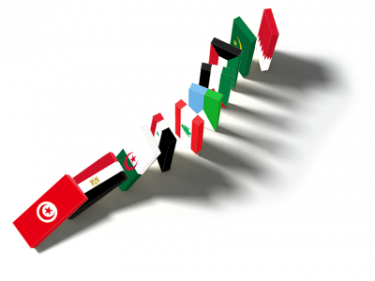
Protests and revolts have swept across the whole of Arabdom, from the Atlantic coastline of Morocco to the shores of the petro-sheikhdoms of the Persian Gulf. In this regard, U.S. and E.U. double-standards are being applied to these events. There is a selective focus and condemnation by the White House and the European Union at play in regards to which Arab protests and protest leaders they support.
Regardless of the direction of these revolts and protests and the reaction of outside players, a new dynamic is taking shape. Democracy has not yet emerged, what is beginning to emerge is a new wave of pan-Arabism. This re-invigorated pan-Arabism will prove a challenge to the ongoing efforts to further fragment and weaken the Arab World.
The Categories of Protest and Revolt in The Arab World
In regards to the mass protests and popular revolts, today the states of the Arab World can be categorized into five groupings or categories. These categories are the following:
Group 1 – Arab countries that are in a state of civil war;
Group 2 – Arab countries that have populations that have revolted;
Group 3 – Arab countries where the people are currently protesting and are on the verge of revolt;
Group 4 – Arab countries where the groundwork for revolts are taking shape;
Group 5 – Arab countries where there are no revolts.
Each category will be discussed and summarized. It must be cautioned that these groupings are not static either and likely to evolve.
The Typologies of Benefit
Taking into account U.S., E.U., and Israeli foreign policy these protests and revolts can also categorized within two different typologies. The latter can be used to explain the reactions of the U.S., the E.U., and Tel Aviv and their respective mainstream media coverage of these events.
The typologies are:
(A) Arab countries where the protests and possible outcomes would be beneficial to the interests of Washington, Israel, and the European Union;
(B) Arab countries where the protests and revolts go against the interests of Washington, Israel, and the European Union.
It should, however, also be cautioned that the outcomes of these protests and revolts are unpredictable. The behaviour of Washington and Brussels suggest that they want to cash in on projected outcomes to reinforce their geo-political influence. Both the U.S. and the E.U. seek to”manage democratization” in the Arab World to thier benefit.
The “agency of the Arab people,” namely the grassroots, which the U.S. and its allies underestimate, has a significant role to play in these events. It is this process of an unfolding mass movement that makes these revolts unpredictable. Coupled with pan-Arabism, a potent force is arising.
The Arab people ultimately constitute a major challenge to Washington and its cohorts.
Unlike in Eastern Europe during the colour revolutions, the Arab regimes are supported by Washington. The Arab people are aware of U.S. and E.U. double-standards. Arabs know full well that the U.S. and its E.U. allies are not the vanguards of democracy and liberty.
In regards to Israel, Tel Aviv sees instability and chaos in the Arab World as serving its interests. Israel is not cutting itself off from the events in Arabdom. The Israeli strategy, in seamless alignment with both the U.S. and the older British strategies in the Middle East-North Africa (MENA) region, has always been to weaken and divide the Arab states. Israel has supported balkanization in the MENA region wherever it can. The Yinon Plan is very much alive today in what can henceforth be called the “Yinon Approach.” The strategy is named after Oded Yinon, a Israeli foreign policy analyst who outlined the “Zionist strategy” for breaking up and balkanizing the Arab World. [1]
The plan operates on two essential premises. To survive, Israel must (1) become an imperial regional power, and (2) must effect the division of the whole area into small states by the dissolution of all existing Arab states. Small here will depend on the ethnic or sectarian composition of each state. Consequently, the Zionist hope is that sectarian-based states become Israeli satellites and, ironically, its source of moral legitimation.
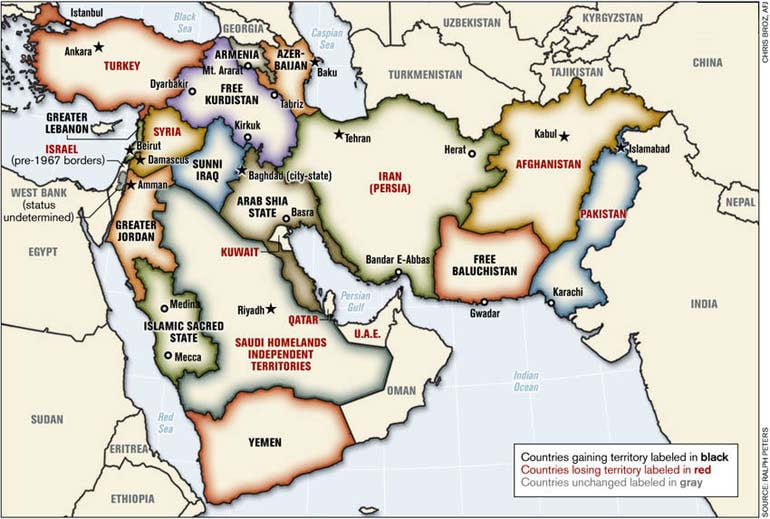
Note: The following map was prepared by Lieutenant-Colonel Ralph Peters. It was published in the Armed Forces Journal in June 2006, Peters is a retired colonel of the U.S. National War Academy. (Map Copyright Lieutenant-Colonel Ralph Peters 2006).
Although the map does not officially reflect Pentagon doctrine, it has been used in a training program at NATO’s Defense College for senior military officers. This map, as well as other similar maps, has most probably been used at the National War Academy as well as in military planning circles.
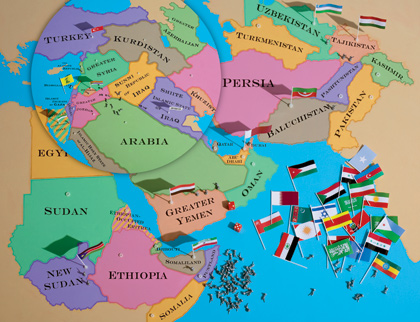
Note: The following map was drawn by Holly Lindem for an article by Jeffery Goldberg. It was published in The Atlantic in January/February 2008. (Map Copyright: The Atlantic, 2008).
The “Yinon Approach” in the Middle East and North Africa
While there is a move for unity amongst the people of the Middle East and North Africa, there is also a counter-push seeking their division. Either directly or indirectly, the Yinon Approach has been operational amongst the Arabs and in their region. In the backdrop, it is also a force in the Arab World.
According to the Yinon Plan, Iraq was the largest Arab threat to Tel Aviv. That threat was removed with the 2003 Anglo-American invasion of Iraq. Currently, Iraq is divided alongside Kurdish, Sunni Muslim Arab, and Shiite Muslim Arab lines. Political parties in Iraq are increasingly based on sectarian schemes. The power sharing arrangements in Baghdad increasingly resemble those in Beirut, Lebanon. Since 2003, the U.S. has actively pushed ahead with a soft form of balkanization in Iraq through federalization. Moreover, Israel has been a major supporter of the Kurdistan Regional Government (KRG) in Iraq.
Along with its U.S. and Western European partners, Israel is working to divide Lebanon and destabilize Syria through the Special Tribunal for Lebanon (STL). It can even be said that Tel Aviv has its own version of a Zionist lobby in Lebanon within the March 14 Alliance. It should come as no surprise that Bashar (Bachir/Bashir) Gemayal, an Israeli ally and the assassinated former president of Lebanon, wanted Lebanon to become a de-centralized federal state with a canton system modelled on Switzerland. Only in Lebanon the canton system would be based on ethno-religious and confessional lines, rather than on linguistic demarcations as in the Swiss confederation.
Instead of uniting the Lebanese, such a system would further magnify the sectarian atmosphere in Lebanon and play into the hands of Washington and Tel Aviv.
The Israelis have divided Palestine with the instigation of a Palestinian mini-civil war in the Gaza Strip. The Israelis even gleefully began to talk about a “three state solution” after the Hamas-Fatah split in 2007. In Turkey, the Alawis (Alavis in Turkish) are beginning to demand greater recognition by Ankara. In Egypt, there has been a campaign against the Coptic Christians with the objective of creating Muslim-Christian tensions. In Iraq too, Christians have been targeted by unknown forces. Sudan has been balkanized with the secession of South Sudan, which Israel heavily supported and armed. In Libya there is a foreign-supported push to manipulate tribal difference and divide the country along the lines of Eastern Libya and Western Libya. At the same time, the House of Saud has been encouraging a confessional divide between Shia Muslims and Sunni Muslims and between Arabs and Iranians.
Israel, like the U.S. and the E.U., is working to take advantage of the upheavals in the Arab World. It has intensified its sporadic attacks on Gaza while the Arab World has been distracted with the events in Tunisia, Egypt, Libya, and elsewhere. Yet, this Yinon Approach will increasingly be challenged by pan-Arabism. The cooperation between Syria, Turkey, and Iran to form a regional bloc and common market may also prove to defy the Yinon Approach. In this context, Tehran is also working to support the protests in the Arab World and to align Iran with them.
Who Falls into What? Categorizing the Arab States
Group 1
Although the fighting in Libya is being exaggerated and embellished, the Libyan Arab Jamahiriya is the only Arab state that falls into the first category of an Arab state undergoing a state of civil war. Yemen may also fall into this group at some point and it can be argued that Yemen is even a part of it too, because of the fighting in 2010 between Yemenite government forces (with the help of the U.S., Britain, Saudi Arabia, and Jordan) and Yemenite rebels.
In Yemen and Libya, however, there is a difference that must be emphasised. It is in the interests of the U.S. and its allies to have President Ali Abdullah Saleh in power. The U.S. has no alternative to Saleh. In Libya, the U.S. is actively working to remove Colonel Qaddafi so that Washington and its allies can appropriate Libyan energy reserves and financial assets.
The alternative in Tripoli to Qaddafi is possibly a divided leadership structure comprised of an alliance of former regime officials who defected and external groups supported by Washington, like the National Front for the Salvation of Libya. On the other hand, a Libya divided into several states or fiefdoms with prolonged fighting could also be a U.S. objective in Libya.
Group 2
Egypt and Tunisia fall into the second category. The mood of the people has changed in both Arab republics, but the political and economic status quo remains unchanged. U.S. and E.U. interests have remained unaffected and are intact.
As mentioned earlier, the “agency of the Arab people,” something that the U.S. and its allies underestimate, does have a significant role to play. The continued protests in Tunisia and Egypt show the continuation of dissatisfaction, because popular demands were not met. The psyches of the Tunisian and Egyptian people have changed. Despite the current status quo and Washington’s aims, the outcomes of the revolts in Tunisia and Egypt will work against the interests of Washington, Brussels, and Tel Aviv in the end.
Group 3
The third grouping of Arab states includes Bahrain, Yemen (if it is not considered a part of the first group with Libya), and Oman. Earlier is could have been said that Iraq could also possibly not fall into this third category. Massive protests and riots have broken out across Iraq from Baghdad and Basra to Sulaymaniah. It can now be said that Iraq is a part of this category too. These respective Arab states could ignite with open revolt and therefore become re-classified into the second group of Arab countries.
The protests in Bahrain, Yemen, Oman, and Iraq all work against the interests of Washington and the European Union. In Iraq the people are demanding that oil deals be cancelled. Both Washington and Brussels specifically support the status quo in the Arabian Peninsula. This is why they have mostly ignored the protests in Iraq and the Arabian Peninsula or presented them in a different light than the events in Tunisia, Egypt, and Libya.
Group 4
The fourth group includes the Hashemite Kingdom of Jordan, Morocco, Algeria, Kuwait, Saudi Arabia, and the Israeli-occupied West Bank that is managed for Tel Aviv by Mahmoud Abbas and the corrupt Palestinian Authority. Protests have taken place in all these Arab states and the occupied West Bank at various levels. The groundwork for revolt in these states and the West Bank is being prepared by internet-based social media groups, dissidents, and opposition officials.
The release of the Palestinian Papers by the Qatar-based Al Jazeera Network has also heightened already rising tensions amongst the Palestinians. Palestinians are now pressuring Hamas and Fatah to form a unity government. Fatah is especially under a lot of pressure and scrutiny in the West Bank. Because of the mounting pressure, Mahmoud Abbas is now talking about political change as a means to pre-empt any revolt against him. If a revolt breaks out in the West Bank, the U.S. and Israel could work to position Mustafa Barghouti into the presidency of the Palestinian Authority. Despite their high fanfare in Washington and Brussels, Prime Minister Salam Fayyad and Hanan Ashrawi would be too unpopular. Mohammed Dahlan and other ranking Fatah members, except for Marwan Barghouti, would not be well received either.
It is a matter of time before protests and revolt emerge in these places of Arabdom. Protest and popular revolt in these places would also be against the interests of the U.S., the E.U., and Israel. Algeria may prove to be the exception in the fourth group. Like Libya, Algeria also exercises a degree of autonomy in regards to the U.S. and the European Union.
Group 5
The fifth and last group of Arab states includes Lebanon and the United Arab Emirates. Qatar and Syria could also be included in this group. In comparison to the other Arab states, both Qatar and Syria have been peaceful, although there is potential unrest and the possibility of protests in both Qatar and Syria.
In the case of Qatar the agitation appears to be internal and aimed at the Emir of Qatar, Sheikha Mozah bint Naser Al-Missned, the autocratic political structure in Qatar, and Qatari ties to Israel. In the case of Damascus the agitation widely appears to be driven externally by Syrian expatriates. With the recent appointment of a new U.S. ambassador to Syria, Washington is also set on a path towards eventually instigating and supporting revolt in Syria against President Bashar Al-Assad.
Mauritania, Kuwait, and Sudan do not qualify for this group either, because protests have broken out in these states. In Kuwait protests have already taken place that could place it in the third grouping. One set of protests was launched by Kuwaiti Bedouins that demanded that they be recognized and given legal rights as Kuwaiti citizens. Additional protests have been against the Kuwaiti state structure and against the discrimination of Shiite Muslims.
The Changing Winds in Iraq
In Iraq, after months of negotiations with Prime Minister Nouri Al-Malaki, Ayad Allawi has refused to accept a position of power as the chair of the Iraqi National Council for Strategic Policy. The position of the head of the Iraqi National Council for Strategic Policy is meant to counter-balance the role of the prime minister of Iraq. Ayad Allawi announced that he would not take the position at a press conference in Najaf alongside Moqtada Al-Sadr on March 3, 2011.
Whereas Allawi is known for being aligned to U.S. and British interests, Moqtada Al-Sadr is known for his opposition to the U.S. and Britain. At the press conference Allawi made an interesting, if not pragmatic, statement: “We are not seeking [state or government] positions, but looking for the interests of the people, the progress of Iraq and [the] stability [of Iraq.]” [2] In this context, Ayad Allawi can be seen as a weather vane or windsock in regards to the political situation and the mood of the people in Iraq. Revolt may inflame Iraq and Allawi may be positioning himself accordingly.
Since the protests in Iraq are being discussed it should be pointed out that Iraq sits at the borders of the Iranic World and the Arab World, as well as the Turkic World to a much lesser degree. These three conceptual realms can also be compounded and distinguished as the Turko-Arabo-Iranic World. Getting to the point, Kurdish sensitivities must be addressed. The Iraqi protests, like Iraq itself, cannot simply be characterized as Arab in nature. While the protests are purely Iraqi, they are characterized as partially Arab and partially Kurdish.
The Threat of Foreign Intervention in Lebanon
A storm is gathering over Beirut. Lebanon could join the first grouping of Arab states with Libya. Although weaker, Saad Hariri and his March 14 Alliance are itching for confrontation with Hezbollah and its political allies in Lebanon. This itch is far more than mere politicking.
Over the years the Hariri-led March 14 Alliance has worked with the U.S., the E.U., Saudi Arabia, Mubarak, Jordan, and even Israel to pave the way for foreign intervention in one form or another in Lebanon against the Lebanese Resistance. Hariri and the March 14 Alliance have also been very close allies to all the Arab dictators and absolute monarchs. The support that the March 14 Alliance receives from the U.S., Britain, France, and Saudi Arabia is not due to any self-styled democratic values that its members talk about, but due to its willingness to transform Lebanon into a colony.
In 2006, Hariri and his allies covertly supported Israel in its war against Lebanon. When Lebanon was being attacked, they ordered the Lebanese military to stand-down in the face of Israeli aggression. After the Israeli defeat in 2006, they went on to import Fatah Al-Islam into Lebanon in the hopes of using it as an armed option against Hezbollah and its allies; they would later shamelessly try to blame the Palestinian refugees in Lebanon for the materialization of Fatah Al-Islam. They also tried to dismantle the vital communications network used by Hezbollah in 2008.
Now, Hariri and his political allies loudly criticize the Lebanese Resistance with their renewed political acquisition about its weapons. This is ironic, because the March 14 Alliance themselves have been arming their own militias over the years. This was proven during the fighting of May 2008 when both sides brandished guns. The groups within the March 14 Alliance have also been the ones who used militias in the past exclusively for fighting their own Lebanese countrymen. They have a history of fighting other Lebanese and a disregard for democracy.
A pause is in order to consider the reasons why Hariri and his crew have armed themselves. It has not been to defend Lebanon from the external threat of Israel, but they have been arming themselves for internal fighting in Lebanon. Hariri and the March 14 Alliance only talk about democracy, because they do not have enough force to impose themselves in Lebanon.
Today, they are attempting to use the Special Tribunal for Lebanon (STL) as a snare to internationally indict Hezbollah. Once an indictment is made at the international level, the U.S. and its allies could intervene on the pretext of international justice. Washington and Brussels could also be called upon for help in bringing Hezbollah to justice by Hariri and the March 14 Alliance.
Hariri did not foresee the plug being pulled by Hezbollah and its political allies on his government and his own impotence to regain power. This has been a crushing blow to the Hariri family. They have run out of cards and are working to keep the STL alive. As long as the STL remains, it leaves an open option for some form of foreign intervention for the U.S. and its E.U. cohorts into Lebanon.
Increasingly, the language of Hariri is that of confrontation and sectarianism. Even without the STL, Hariri and the March 14 Alliance may yet ignite another civil war in Lebanon. They can also still play the sectarian card and Hezbollah and its political allies are well aware of this. This is why Najib Al-Mikati and Hezbollah are moving forward cautiously in an effort to dismantle the sectarian card. Through starting a civil war the Lebanese could risk inviting a U.S. and NATO intervention in Lebanon.
Double-Standards Are at Play
Washington and the E.U. have little regard for real democracy and freedom as is evident from their reaction to the outcome of the democratic elections in the occupied Palestinian Territories. In 2006, Hamas won the Palestinian elections. The U.S., the E.U., and Israel immediately refused to recognize the Palestinian elections.
Despite the fact that Fatah lost the elections, Washington and its allies also forced Hamas to allow Fatah to co-manage the Palestinian government. Democracy is only acceptable when it works in the interests of the U.S. and Brussels. Today, these powers have let Mahmoud Abbas run the occupied West Bank as their agent and as a quasi-dictator.
In Sudan, Washington and Brussels have put undue pressure on Khartoum, while supporting the balkanization of the country. Yet, they have said nothing about the continued occupation of Western Sahara by Morocco.
Western Sahara is a case of outright occupation, which has been widely ignored. The Sahrawis or the Western Saharans have also faced attacks from Morocco for wanting independence. Even during the referendum in South Sudan the Sahrawis were attacked by Moroccan forces during their protests, but there was no widely publicized condemnation by the U.S. or Brussels. [3] No big Hollywood stars have taken up their cause either in major public campaigns.
In Iraq major protests by Iraqi Arabs and Iraqi Kurds are underway, but they have been ignored by the European Union and the U.S. government. Amongst the demands of Iraqi protesters is a key one that Iraqi oil wealth be redistributed and under the control of the Iraqi people. In Bahrain blatant brutality was used against the Bahraini protesters, which were not just Shiite Muslims as unknowledgeable people and propagandists claim. Yet, the reaction of Washington and Brussels towards the Al-Khalifa family was diametrically different than their reaction towards Colonel Qaddafi in Libya.
In summary, the U.S. and the E.U. continue to apply double-standards. Their policies towards the Arabs are riddled with hypocrisy. Their actions are based on their own interests. Even in the midst of the Egyptian protests, U.S. Vice-President Joseph Biden refused to even refer to Mohammed Husni Mubarak as a dictator in what can only amount to a display of utter hypocrisy. [4]
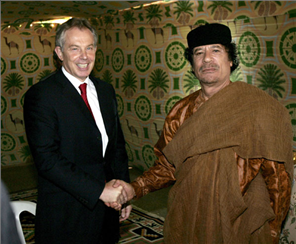

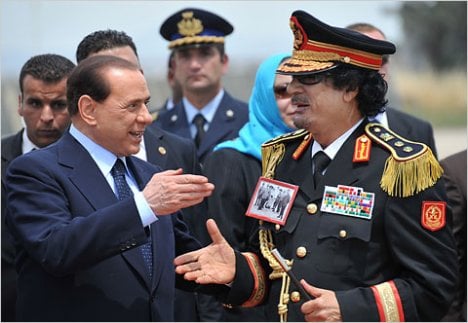
Pan-Arabism versus the Yinon Approach
Tel Aviv, Washington, and Brussels all oppose Arab unity. Historically, they have worked to divide the Arabs. In the past, the British separated Kuwait and Iraq, Palestine and Jordan, and Egypt and Sudan from one another, while the French separated Algeria and Tunisia in the Maghreb and Lebanon and Syria in the Levant from one another. The Yinon Approach is a continuation of this project.
U.S. policy is part of this continuum. The White House has worked with Israel and the House of Saud to divide and isolate the Palestinians through a Hamas-Fatah split. In Iraq the process of national estrangement has been a major endeavour for Washington and its allies. Sudan has been fractured and now a civil war is being fuelled in Libya. Arab League member Somalia has also been divided into Puntland, Somaliland, and South Somalia. South Somalia has also been divided to an even greater extent.
The interests of the U.S. government, Brussels, and Israel are to keep the Arabs divided in separate “feeble states.” There is, however, a new dynamic that is emerging in the Arab World. This new dynamic emerging from the upheavals and protests potentially challenges the Yinon Approach, which is being applied against the Arab people.
Pan-Arabism is a new dynamic, which constitutes a potent force. The trend of decades of divisions can eventually be reversed. Nor will the issue of Palestine be left in the hands of outside powers for much longer.
The plurality of Arabdom was constructed on the basis of inclusiveness and multi-culturalism. The Arab identity is a very open and inclusive one that has a wide embrace. According to the Arab League’s 1946 definition or description: “An Arab is a person whose language is Arabic, who lives in an Arabic speaking country, [and] who is in sympathy with the aspirations of the Arabic speaking peoples.” [5] This has brought different civilizations, ethnicities, creeds, traditions, and lands together and united them under one roof, from the pre-Arabized Levantine peoples to the pre-Arabized Egyptians, Nubians, and Berbers.
Pan-Arabism gives a political will to this inclusive Arab identity and paves the way for a political project amongst the Arab peoples. Thus, regardless of the initial successes or failures of these revolts, the Arab march towards unity as a political and popular project is an eventual assurance. Nor can its tides be contained for long as a new geo-political and sociological reality begins to take shape for the Arab Nation.
Mahdi Darius Nazemroaya specializes on the Middle East and Central Asia. He is a Reseach Associate at the Centre for Research on Globalization (CRG).
NOTES
[1] The Yinon Plan is a strategic Israeli policy put forward by Oded Yinon that advocates that Israel act as an imperialist power and fracture the countries of the Middle East and North Africa into tiny and feeble states.
[2] Alice Fordham, “Allawi backing away from the Iraqi government deal,” Los Angeles Times, March 4, 2011.
[3] “Deadly clashes as Morocco breaks up Western Sahara camp,” British Broadcasting Corporation (BBC), November 8, 2010.
[4] Daniel Murphy, “Joe Biden says Egypt’s Mubarak no dictator, he shouldn’t step down…,” Christian Science Monitor, January 27, 2011.
[5] William D. Wunderle, Through the Lens of Cultural Awareness: A Primer for US Armed Forces Deploying to Arab and Middle Eastern Countries (Washington D.C.: U.S. Government Printing Office, 2006), p.25.

